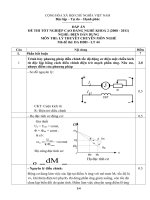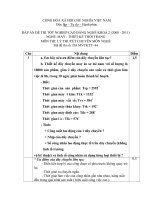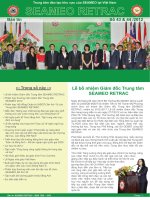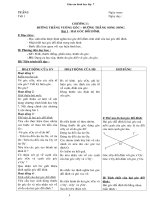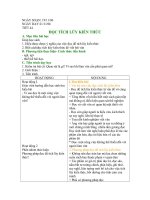PASSAGE 44
Bạn đang xem bản rút gọn của tài liệu. Xem và tải ngay bản đầy đủ của tài liệu tại đây (47.66 KB, 4 trang )
PASSAGE 44
There is a new type of small advertisement becoming increasingly common in newspaper classified
columns. It is sometimes placed among “situations vacant”, although it does not offer anyone a job, and
sometimes it appears among “situations wanted”, although it is not placed by someone looking for a job,
either. What it does is to offer help in applying for a job.
“Contact us before writing your application”, or “Make use of our long experience in preparing your
curriculum vitae or job history”, is how it is usually expressed. The growth and apparent success of such a
specialized service is, of course, a reflection on the current high levels of unemployment. It is also an
indication of the growing importance of the curriculum vitae (or job history), with the suggestion that it
may now qualify as an art form in its own right. There was a time when job seekers simply wrote letters
of application. “Just put down your name, address, age and whether you have passed any exams”, was
about the average level of advice offered to young people applying for their first jobs when I left school.
The letter was really just for openers, it was explained, everything else could and should be saved for the
interview. And in those days of full employment the technique worked. The letter proved that you could
write and were available for work. Your eager face and intelligent replies did the rest.
Later, as you moved up the ladder, something slightly more sophisticated was called for. The advice then
was to put something in the letter which would distinguish you from the rest. It might be the aggressive
approach. “Your search is over. I am the person you are looking for”, was a widely used trick that
occasionally succeeded. Or it might be some special feature specially designed for the job interview.
There is no doubt, however, that it is increasing number of applicants with university education at all
points in the process of engaging staff that has led to the greater importance of the curriculum vitae.
Question 1. What does the phrase “make use of” in the second paragraph probably mean?
A. Make a day of.
B. Benefit from
C. Get on with
D. Put up with
Question 2. The new type of advertisement which is appearing in newspaper columns___________ .
A. informs job hunters of the opportunities available
B. promises to offer useful advice to those looking for employment
C. divides available jobs into various types
D. informs employers of the people available for work
Question 3. Nowadays a demand for this specialized type of service has been created because ________.
A. there is a lack of jobs available for artistic people
B. there are so many top-level jobs available
C. there are so many people out of work
D. the job history is considered to be a work of art
Question 4. In the past it was expected that first job hunters would
A. write an initial letter giving their life history
B. pass some exams before applying for a job
C. have no qualifications other than being able to read and write
D. keep any detailed information until they obtained an interview
Question 5. Later, as one went on to apply for more important jobs, one was advised to include in the
letter__________ .
A. something that would distinguish one from other applicant’s
Page 1
B. hinted information about the personality of the applicant
C. one’s advantages over others in applying for the job
D. an occasional trick with the aggressive approach
Question 6. The word “worked” in the third paragraph is closest in meaning to _____________.
A. earned money
B. was used
C. was effective
D. functioned
Question 7. What does the word “which” in the fourth paragraph refer to?
A. the advice
B. the letter
C. the rest
D. approach
Question 8. The curriculum vitae has become such an important document because _____________.
A. there has been an increase in the number of jobs advertised
B. there has been an increase in the number of applicants with degrees
C. jobs are becoming much more complicated nowadays
D. the other processes of applying for jobs are more complicated
ĐÁP ÁN
1-B
2-B
3-C
6-C
7-B
8-A
4-D
5-A
LỜI GIẢI CHI TIẾT
Question 1:
Cụm từ “make use of” trong đoạn thứ hai có nghĩa là gì?
A. Làm một ngày.
B. Lợi ích từ
C. Tiếp tục với
D. Đưa lên với
=> make use of (tận dụng)= bennefit from: lợi ích từ
Question 2:
Loại quảng cáo mới xuất hiện trên các cột báo ____.
A. thông báo cho những người tìm việc làm những cơ hội có sẵn
B. hứa sẽ cung cấp lời khuyên hữu ích cho những người tìm kiếm việc làm
C. chia các cơng việc có sẵn thành nhiều loại
D. thông báo cho người sử dụng lao động của những người có sẵn cho cơng việc
=> Dẫn chứng: There is a new type of small advertisement becoming increasingly common in newspaper
classified columns. It is sometimes placed among “situations vacant”, although it does not offer anyone a
job, and sometimes it appears among “situations wanted”, although it is not placed by someone looking
for a job, either. What it does is to offer help in applying for a job.
Có một loại quảng cáo nhỏ mới ngày càng trở nên phổ biến trong các cột được phân loại báo. Đôi khi, nó
được đặt trong số các tình huống bỏ trống, mặc dù nó khơng cung cấp cho bất kỳ ai một cơng việc, và đơi
khi nó xuất hiện trong số các tình huống của Wap muốn, mặc dù nó cũng khơng được đặt bởi ai đó đang
tìm việc. Những gì nó làm là để cung cấp trợ giúp trong việc xin việc.
Question 3:
Ngày nay, nhu cầu về loại dịch vụ chuyên biệt này đã được tạo ra bởi vì ____.
A. thiếu việc làm cho người làm nghệ thuật
B. có rất nhiều cơng việc cấp cao nhất có sẵn
Page 2
C. có q nhiều người thất nghiệp
D. lịch sử cơng việc được coi là một tác phẩm nghệ
=> Dẫn chứng The growth and apparent success of such a specialized service is, of course, a reflection
on the current high levels of unemployment.
Tất nhiên, sự tăng trưởng và thành công của một dịch vụ chuyên biệt như vậy là một sự phản ánh về mức
độ thất nghiệp cao hiện nay.
Question 4:
Trong quá khứ, người ta mong đợi rằng những người tìm việc đầu tiên sẽ
A. viết một lá thư kể cuộc sống trước đây của họ
B. vượt qua một số kỳ thi trước khi đi xin việc
C. khơng có bằng cấp nào khác ngoài khả năng đọc và viết
D. giữ bất kỳ thơng tin chi tiết nào cho đến khi họ có được một cuộc phỏng vấn
=> Dẫn chứng: There was a time when job seekers simply wrote letters of application. “[…] The letter
was really just for openers, it was explained, everything else could and should be saved for the interview.
Đã có lúc người tìm việc chỉ đơn giản là viết thư xin việc. […] Bức thư thực sự chỉ dành cho người mở,
nó đã được giải thích, mọi thứ khác có thể và nên được lưu lại cho cuộc phỏng vấn.
Question 5:
Sau đó, khi một người tiếp tục nộp đơn xin việc quan trọng hơn, người đó được khuyên nên đưa vào thư
___.
A. một cái gì đó sẽ phân biệt một từ người nộp đơn khác
B. thông tin gợi ý về tính cách của người nộp đơn
C. một ưu điểm khác so với những người khác trong việc xin việc
D. một thủ thuật khơng thường xun với cách tiếp cận tích cực
=> Dẫn chứng The advice then was to put something in the letter which would distinguish you from the
rest. It might be the aggressive approach. “Your search is over. I am the person you are looking for”, was
a widely used trick that occasionally succeeded. Or it might be some special feature specially designed for
the job interview.
Dịch: Lời khuyên sau đó là đặt một cái gì đó trong bức thư sẽ phân biệt bạn với phần cịn lại. Nó có thể là
cách tiếp cận tích cực. Tìm kiếm của bạn đã kết thúc. Tơi là người mà bạn đang tìm kiếm, là một thủ thuật
được sử dụng rộng rãi mà đôi khi thành cơng. Hoặc nó có thể là một số tính năng đặc biệt được thiết kế
đặc biệt cho các cuộc phỏng vấn việc làm.
Question 6:
Từ “worker” trong đoạn thứ ba có nghĩa gần nhất với ____________.
A. kiếm được tiền
B. đã được sử dụng
C. có hiệu quả
D. hoạt động
=> Dẫn chứng: And in those days of full employment the technique worked. The letter proved that you
could write and were available for work. Your eager face and intelligent replies did the rest.
Dịch: Và trong những ngày làm việc đầy đủ, kỹ thuật làm việc. Bức thư đã chứng minh rằng bạn có thể
viết và sẵn sàng cho cơng việc. Khn mặt háo hức và trả lời thông minh của bạn đã làm phần còn lại.
Question 7:
Từ “which” trong đoạn thứ tư nói đến điều gì?
Page 3
A. lời khuyên.
B. chữ cái
C. phần còn lại
D. cách tiếp cận
=> Dẫn chứng: Later, as you moved up the ladder, something slightly more sophisticated was called for.
The advice then was to put something in the letter which would distinguish you from the rest.
Sau đó, khi bạn di chuyển lên thang, một cái gì đó tinh vi hơn một chút được gọi cho. Lời khun sau đó
là đặt một cái gì đó trong bức thư sẽ phân biệt bạn với những người còn lại.
Question 8:
Sơ yếu lý lịch đã trở thành một tài liệu quan trọng như vậy bởi vì.____
A. đã có sự gia tăng số lượng việc làm được quảng cáo
B. đã có sự gia tăng số lượng ứng viên có bằng cấp
C. cơng việc ngày càng trở nên phức tạp hơn
D. các quá trình xin việc khác phức tạp hơn
Dẫn chứng: There is no doubt, however, that it is increasing number of applicants with university
education at all points in the process of engaging staff that has led to the greater importance of the
curriculum vitae.
Dịch: Tuy nhiên, khơng cịn nghi ngờ gì nữa, việc ngày càng có nhiều ứng viên có trình độ học vấn đại
học ở tất cả các điểm trong quá trình thu hút nhân viên dẫn đến tầm quan trọng lớn hơn của sơ yếu lý lịch.
Page 4

